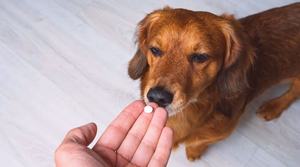
Reviewed & Fact-Checked by
Dr. Chyrle Bonk
Veterinarian (DVM)
Learn more about our Veterinary Review Board »
For pet parents, making sure they stay on top of their dog's health is always a priority, and it can be very disturbing to think there might be something wrong with them.
Some health conditions that affect dogs cannot be prevented however, but they can be made less frightening if they are better understood.
Here is a look at one of those conditions: Von Willebrand’s disease (vWD).
What is Von Willebrand’s Disease?
Von Willebrands is a genetically based disease of the blood that exists in humans as well as dogs.
Dogs with this disorder lack a blood plasma protein - von Willebrand factor (vWF) - that is needed for the clotting of blood. Without this protein, the platelets in the blood don't bind together properly to form a clot.
Dogs with vWD prone to excessive bleeding after even the smallest injury. Cuts and scratches, even small ones, can become a serious, even potentially deadly, problem for dogs affected by the disease.
Here's a quick video that simplifies blood clot formation.
Types of von Willebrand’s Disease
Although they are all very similar, there are considered to be three different types of vWD.
The first, and most common, Type 1, is very mild and may not be particularly problematic as long as a dog's pet parent is aware of the problem.
Types 2 and 3 tend to be far more serious and usually call for carefully managed care.
Are certain breeds more susceptible to the development of von Willebrand’s Disease?
Von Willebrands occurs as an inherited condition and while it could potentially affect any dog there are some breeds in which it is more likely the disease will be diagnosed.
Type 1, the mildest form of the condition, is most commonly found in standard Poodles, Dobermans, Akitas, Golden Retrievers, Airedales, Bernese Mountain Dogs, Dachshunds, German Shepherds, Greyhound, Irish Wolfhounds, Schnauzers, Shetland Sheepdogs, Corgis and others.
Type 2 is seen most often in German Shorthaired or Wirehaired Pointers.
Type 3, which is very rare, is usually found in Scottish Terriers, Shelties and Chesapeake Bay Retrievers.
It should be noted that some dogs with hyperthyroidism the incidence of the blood clotting disease may also be increased, and that can affect over 50 different breeds.
How can I tell if my dog has von Willebrand’s Disease?
In terms of signs that can be observed easily by a pet parent it is excessive bleeding that is most noticeable.
As Type 1 is a mild form of the disease that usually manifests itself when the dog is young. Pet parents may notice that their dogs seems to bleed more than expected after receiving a small scratch at playtime.
In the cases of Types 2 and 3 the disease is more serious and may manifest itself as excessive bleeding from the nose or mouth for no apparent reason, as dark, tarry, bloody stools or as unexpected rectal bleeding.
In these cases, excessive bleeding from accidental injury also occurs and can be far more serious.
How is von Willebrand’s Disease diagnosed?
Whenever vWD is suspected a vet will perform a series of blood tests as well as a bleeding time test. The latter sees a vet make a tiny incision, usually in the dog's gum, and then time how long it takes for the blood from the clot to heal.
This has to be performed under strict supervision because if a dog is suffering from one of the more severe forms of the disease even this very small, intentional injury could be harmful and steps would need to be taken to staunch the bleeding immediately.
If a bleeding time test shows concern for vWD, a further blood test to be done to determine the amount of von Willebrand factor in a dog's blood. This will also help to determine the type.
These days DNA testing can also be helpful, as it can help determine whether or not to pup is a carrier of the defective gene that leads to vWD.
These tests also allow breeders to identify such dogs as puppies and ensure that they are not allowed to breed, thus reducing the incidence of the condition in their bloodline.
How Is von Willebrand’s Disease treated?
Von Willebrand’s Disease cannot be cured, it is a lifetime disorder. It can, however, be managed, often very well and to the point it rarely really affects a dog's day to day life.
In cases where a dog is diagnosed with Type 1 vWD formal treatment will often not be needed, but increased vigilance and awareness on the part of the pet parent is a must, as certain things will put their dogs at greater risk.
In the cases of dogs affected with Type 2 or Type 3 forms of the disease the need for awareness is even more crucial.
Dogs should not engage in rough play with others (as this may cause accidental injury) and any small injury that does result in bleeding should be attended to immediately and the bleeding staunched with a bandage or suture. Severe injuries may require a blood or blood product transfusion.
These dogs should not be allowed to play with hard toys that may damage and cut their gums and real bones should be avoided for the same reasons.
If you have one of the at-risk breeds, consider having a screening test done, especially if your dog has to undergo surgery.
Your vet will also need to be careful about prescribing any medications that affect blood clotting as a side effect.
On the whole, dogs with vWD can leave full, long lives as long as special precautions are taken.



